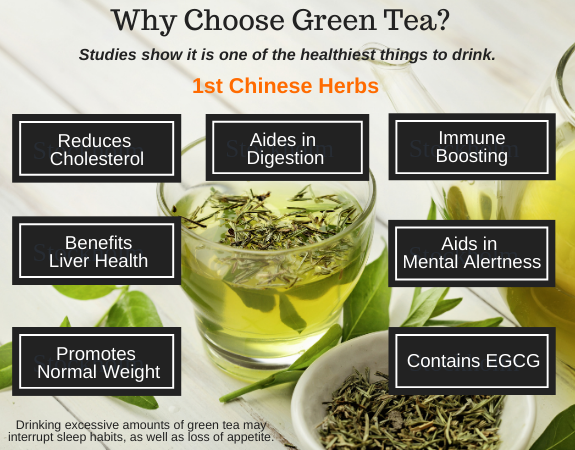

NuHerbs Lab Tested
Andrographis Herb (Chuan Xin Lian) - Cut Form 1 lb. - Nuherbs
Herbal Information for Andrographis Herb in Cut Form
Green tea is a true tea, made with leaves from the camillia shrub (camilla sinesis). Green tea has a long history of use to benefit a variety of health concerns.
Green tea is a type of tea that is made from the leaves of the Camellia sinensis plant. Unlike black tea, green tea is not fermented or oxidized during processing, which helps to preserve the natural compounds and antioxidants found in the leaves.
Green tea has a unique flavor profile that is often described as vegetal, grassy, or even slightly nutty. It can be enjoyed plain or with a touch of sweetener, and is often served hot, although it can also be enjoyed iced.
Green tea has been associated with numerous health benefits due to its high concentration of antioxidants, including reducing the risk of cardiovascular disease, improving cognitive function, and reducing the risk of certain types of cancer. Additionally, green tea contains caffeine, which can provide a natural energy boost. Overall, green tea is a delicious and healthy beverage that can be enjoyed as part of a balanced diet.
In the 16th century European explorers reported that the hot medicinal drink was used to relieve fever, headache, stomach ache and joint pain. Since that time the amazing benefits of green tea has been expanded.
Current research shows that green tea may help with:

Polyphenols are a powerful antioxidant that is associated with benefiting cardiovascular health. Green tea boasts an extremely high concentration of this health benefiting antioxidant. Have you have ever noticed the slight astringent, bitter taste of green tea? This aspect is attributed to polyphenols.
Catechins- Catechins are a category of polyphenols. In green tea, catechins are present in significant quantities, more specifically; epicatechin (EC), epigallocatechin (EGC), epicatechin gallate (ECG) and epigallocatechin gallate (EGCG). EGCG makes up about 10-50% of the total catechin content and appears to be the most powerful of the catechins – with antioxidant activity about 25-100 times more potent than vitamins C and E. A cup of green tea may provide 10-40mg of polyphenols and has antioxidant activity greater than a serving of broccoli, spinach, carrots or strawberries.
Tannins- Are a group of simple and complex phenol, polyphenol, and flavonoid compounds bound with starches. They have astringent properties and contain variations on gallic acid. All tannins act as astringents, shrinking tissues and contracting structural proteins in the skin and mucosa.
Green teas contain 6 times more antioxidants than black teas.
Camellia Leaves are spread out on floors or racks and allowed to wither for a few hours. The leaves are then heated to remove moisture and to stop the oxidation process. The next step is to dry the leaves until a small amount of moisture remains.
Green teas have long been enjoyed for their health-giving qualities as well as their unique and often subtle flavor. amusingly the aroma and taste can be quite different from one another. The color of the liquor can range from a bright jade green to a pale yellow and is best when consumed without any additions.
Green tea is typically harvested by handpicking the young leaves and buds of the Camellia sinensis plant, which are then quickly processed to preserve their natural flavor and health benefits. The timing of the harvest is critical to ensure the best quality tea.
The timing of the harvest depends on a number of factors, including the weather, altitude, and type of tea being produced. In general, green tea is harvested in the spring or early summer when the leaves are young and tender, and have not yet fully developed their bitterness.
During the harvesting process, experienced tea pickers carefully select only the highest quality leaves and buds, ensuring that only the most tender and flavorful parts of the plant are used. The leaves are then quickly transported to the processing facility to prevent oxidation.
Once at the processing facility, the leaves are typically withered, rolled, and dried using a variety of techniques, depending on the specific type of green tea being produced. This helps to remove excess moisture and activate the natural enzymes in the leaves, which contribute to the flavor and health benefits of the tea.
It’s important to note that green tea can become bitter if steeped for too long or with water that is too hot, so it’s important to pay attention to the water temperature and steeping time. Additionally, the quality of the water used can also affect the taste of the tea, so using fresh, filtered water is recommended for the best flavor.
References:
https://www.healthline.com/nutrition/top-10-evidence-based-health-benefits-of-green-tea#2.-May-improve-brain-function
https://www.ncbi.nlm.nih.gov/pmc/articles/PMC2855614/
https://www.ncbi.nlm.nih.gov/pmc/articles/PMC6412948/
https://www.ncbi.nlm.nih.gov/pmc/articles/PMC3365247/